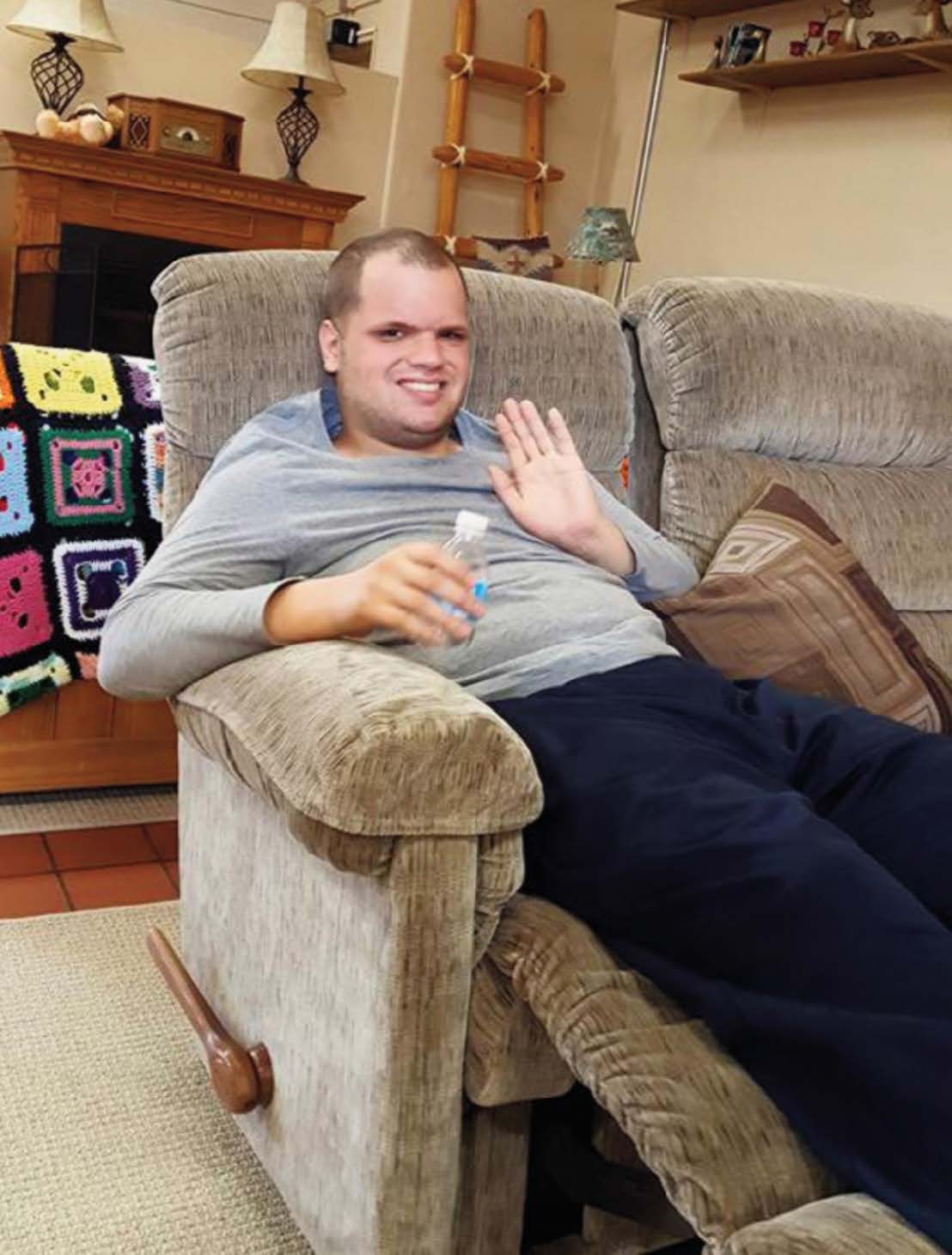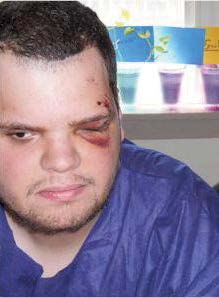
What appeared to be one of the least restrictive settings for Joey – a one-person group home in the community – became the most restrictive for him, because it was most inappropriate for his complex behavioral needs.
OUR SON, JOEY, AGE 25, IS BIG, STRONG AND HANDSOME WITH A MISCHIEVOUS SENSE OF HUMOR, AND A DUAL DIAGNOSIS OF AUTISM AND MENTAL RETARDATION. EIGHTY PERCENT OF THE TIME, HE IS JOY TO BE AROUND, BUT OBSESSIVE-COMPULSIVE THOUGHTS CIRCLE RELENTLESSLY IN HIS MIND, PERIODICALLY BUILDING UP INTO AN ANXIETY THAT CULMINATES IN A DESTRUCTIVE TEMPER TANTRUM.
There is no malice in his anger; he just lashes out wildly, breaking furniture and glass, punching holes in walls, bruising direct care staff in his path, until the neurological storm passes. Afterwards he is remorseful and apologetic, saying "I'm sorry, I'm sorry," over and over while he tries to undo the damage he has wrought. Because of his disability, our son requires close supervision and understanding assistance in a safe place. As a teenager, he attended a residential school where he got his education, held a job, engaged in social activities and made many friends. His maladaptive behaviors were safely managed by the caring, professional staff at the school.
As an adult, he entered the Community Group Home system and his life spiraled into a traumatizing, living hell. Joey was discharged from three different community group home organizations in short space of four years. Because none of the group home staff in any of the three different community group home businesses were able to safely manage our son's behaviors, they arranged for him to be unceremoniously thrown into five different psychiatric wards against his will (using the handy legal mechanism of Section 302), and forced onto 21 different powerful psychotropic medications in varying combinations. Joey spent up to six months at a time confined to a psychi
atric ward while social workers searched for the next new community group home willing to take him.
The psychotropic medications caused Joey permanent neurological damage (Parkinsonian-like tremors in his hands), development of disfiguring female breasts (Risperdal), welts which can lead to life threatening Stevens-Johnson syndrome from Lamictal, intractable insomnia that did lead to psychotic breaks with reality, pre-diabetes and Serotonin Syndrome.

UNHAPPY HOME: While Joey resided in the community group homes, his eye socket was broken and he required 36 stitches in an altercation with community group home staff. We frequently found him covered with mysterious bruises.
Since there were no clinical studies or medical research to indicate that any of the psychotropic drugs he was given were effective as treatment for his disability we suspected the drugs were intended for behavioral management by the community group home but the chemical straitjacket just wasn't working. His behaviors became more frequent, violent and dangerous to himself and staff. While Joey resided in the community group homes, his eye socket was broken and he required 36 stitches in an altercation with community group home staff. We frequently found him covered with mysterious bruises.
Joey went unwashed for days at a time, there was sometimes no soap, no shampoo and no towels made available to him in the community group home apartment. Upon visiting, we were shocked at how badly he smelled. We often found Joey sleeping on a bare mattress in the community group home apartment, fully clothed, with his shoes on. Joey was fed an unhealthy diet of processed food and gained a significant amount of weight.
Joey was always isolated and segregatUNHAPPY HOME: While Joey resided in the community group homes, his eye socket was broken and he required 36 stitches in an altercation with community group home staff. We frequently found him covered with mysterious bruises. ed in a one-person community "group" home with two staff because the group home would not be able to keep other residents safe with him. He was so lonely he phoned us up to 18 times per day. In one group home, on more than one occasion, Joey would elope into the nearby busy street from the apartment risking serious injury and death.
In the Group Home System
In one community group home, staff members also called 911 so frequently that I was told the police warned the group home that the police are "not part of your behavioral program" and if the group home staff continues to call police, "the community group
Joey was denied access to the community swimming pool because of the potential of behavioral outbursts that community group home staff could not handle in public settings.
Neighbors to the community group home apartment would call police during noisy tantrums and even for incidents as petty as Joey's use of a neighbor's nearby garbage can. Joey was taken to see the sexually sadistic movie "Fifty Shades of Grey" by community group home staff which disturbed him so greatly that he phoned me to declare "Tell the police, tell the judge, tell President Obama, I don't like inappropriate video!"
Desperate for appropriate services for our child, we searched and learned about the Pennsylvania state-operated centers for individuals with developmental dis
abilities. Although Joey was eligible for admission, we learned that the Pennsylvania state developmental centers have been arbitrarily closed to admission to Pennsylvania residents. So we petitioned the Pennsylvania courts with a 406 Petition in order to gain entrance for our son to White Haven State Center. After a protracted court battle with the Office of Developmental Programs in Harrisburg, PA, which we won at every level, through State Appeal Court review, Joey finally gained
admission into White Haven State Center in July 2016, and his life turned around.
In less than one year at White Haven, our son is off all medications, taking only fish oil, magnesium and Vitamin D. He still has outbursts but his maladaptive behaviors are safely managed with behavioral techniques by the professional White Haven staff. He is a normal weight, clean, safe, happy and healthy, engaged in many social activities (parties, dances, cookouts, celebrations, movies, games) with fellow residents in a "college campus" type of environment.
Why the Community Group Home Isolated Joey While the "Institution" Succeeded in Giving Him Quality of Life
Community group home advocates might argue that Joey wasn't placed in the "right" community group home to be successful, but since Joey was placed in three different community group home organizations in different parts of the state, (Pittsburg, Bethlehem, Philadelphia) we would argue our son has suffered enough; his horrific experiences proved that community programs are not always the most appropriate. Community group homes tend to have systemic flaws that harm people with disabilities, like our son who has a history of profound problems, often compounded by mental illness, requiring round-the-clock supervision for his safety and the safety of other residents.
Inclusion in the community was and is a myth. My son was never more isolated than when he lived in his one person "group"
home. He wasn't surrounded by understanding and friendly neighbors. His neighbors never invited him to their backyard barbecues. He was more like a prisoner in solitary confinement in a very small prison with two prison guards. Yet, what is restrictive for one person may be the appropriate setting for another person. Restrictiveness is an important concept but to have any meaning, it must be personalized to the needs and wants of each individual. In reality, what appeared to be one of the least restrictive settings for Joey—a one-person group home in the community—became the most restrictive for him, because it was most inappropriate for his complex behavioral needs.
Apartments are therapeutically designed with thick walls to with
stand the force of behavioral outbursts and minimize sensory triggers of light and noise. There is safety furniture Joey cannot throw and break. Professional supervision, clinicians, nurses, fellow frontline staff are on the premises to handle and assist in behavioral crises. Also, on-site supervision provides accountability, oversight and safety for the residents.
A human rights committee provides further oversight. Clients have a community of fellow residents right on the campus facing the same chal
lenges to socialize with in a safe environment. Facility staff are caring, understanding, supportive and stable. Other staff are on-site, providing critical support and back-up. Frontline staff can meet with the clients' on-site professional Treatment Team to brainstorm solutions to problems.
The campus environment is stable, structured, safe and appropriate for Joey. On-campus workshop, swimming pool, gymnasium, chapel, café and other facilities, scheduled parties, dances and events help provide a wonderful quality-of-life for residents. Schedules are structured and predictable. Regularly-scheduled trips into the outside community are available for residents who can successfully handle and negotiate the challenges of the community environment for a short period of time.
AT WHITE HAVEN STATE CENTER, CLIENTS HAVE A COMMUNITY OF FELLOW RESIDENTS RIGHT ON THE CAMPUS FACING THE SAME FACILITY STAFF ARE CARING, CHALLENGES TO SOCIALIZE WITH IN A SAFE ENVIRONMENT. UNDERSTANDING, SUPPORTIVE AND STABLE.
Our family will be forever grateful for White Haven Center. Please join with us in support of its important work and in support of open admissions for eligible persons to the Pennsylvania state-operated developmental centers.